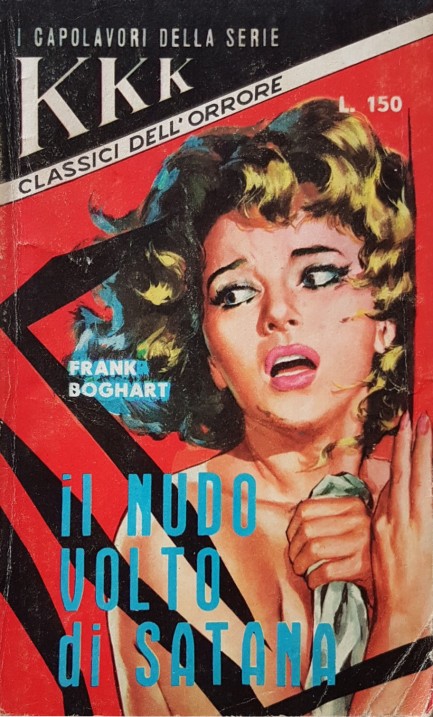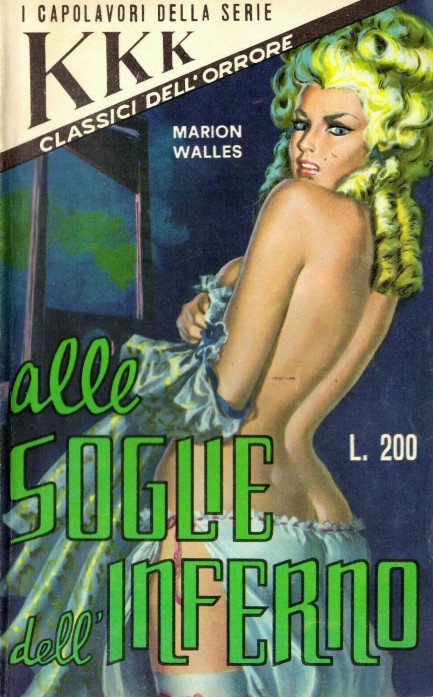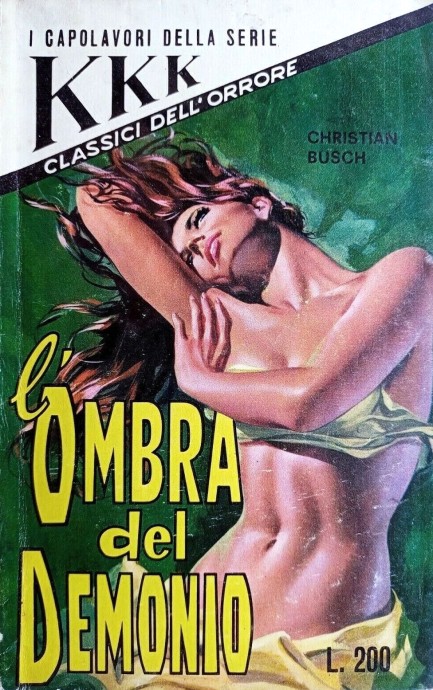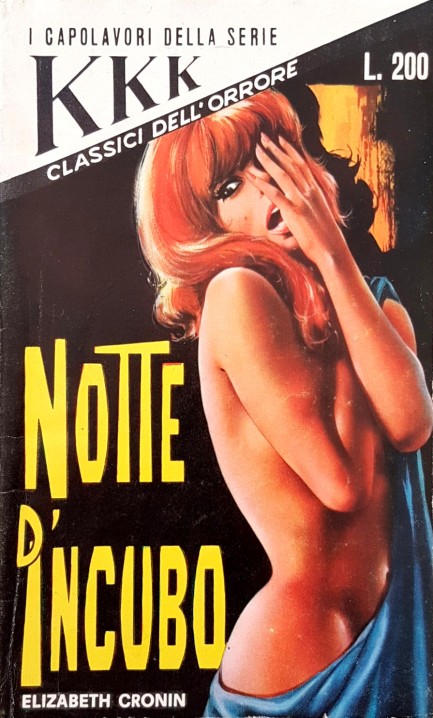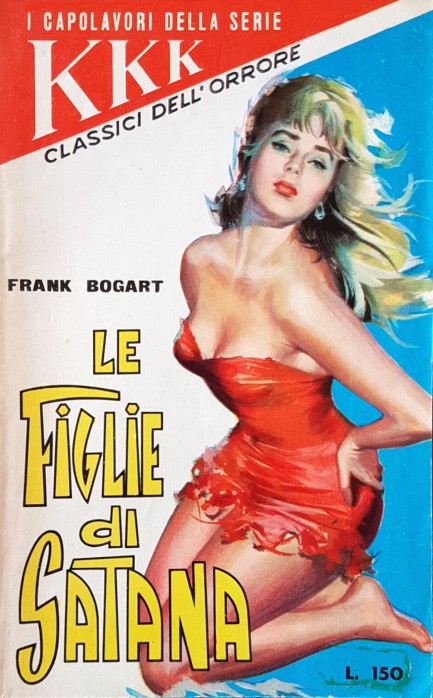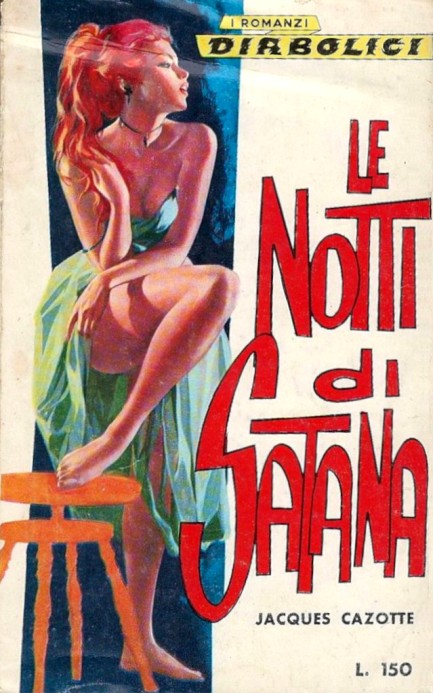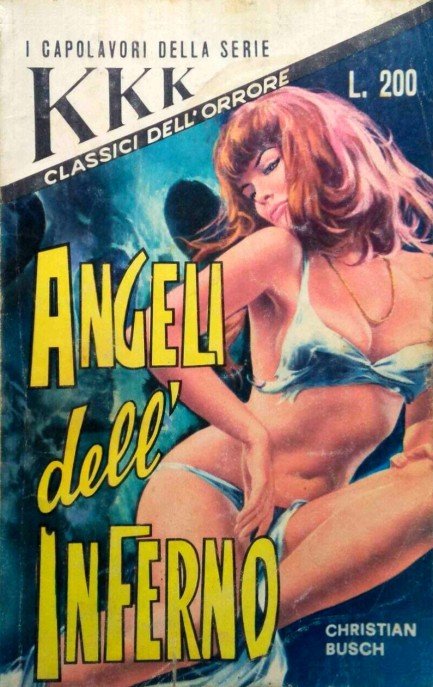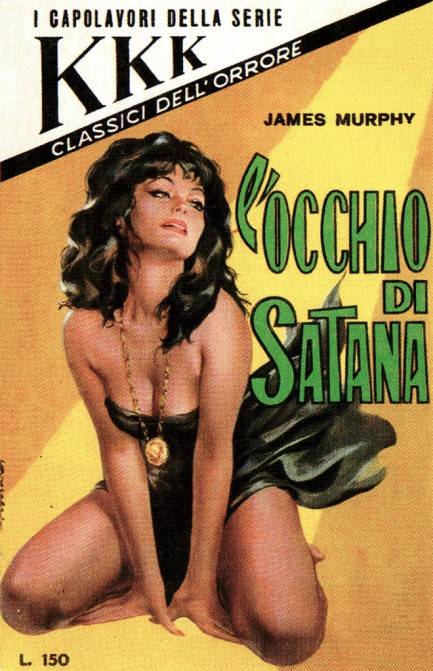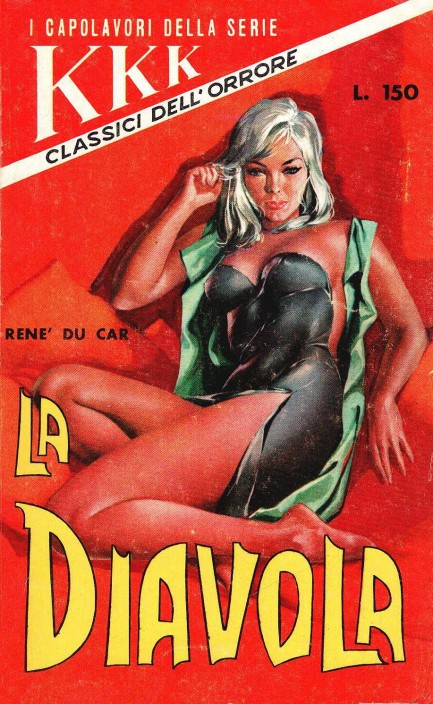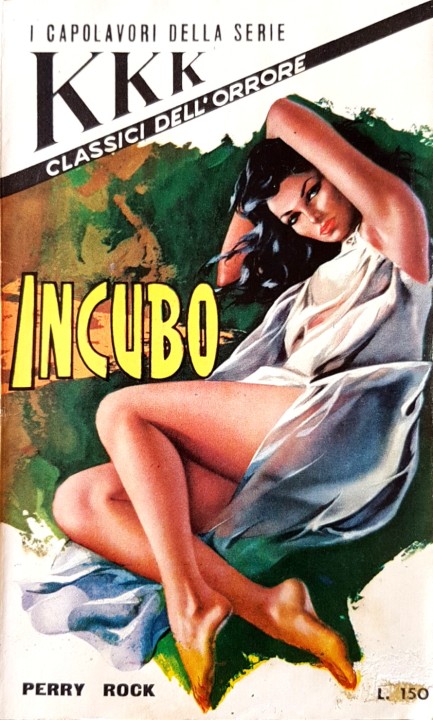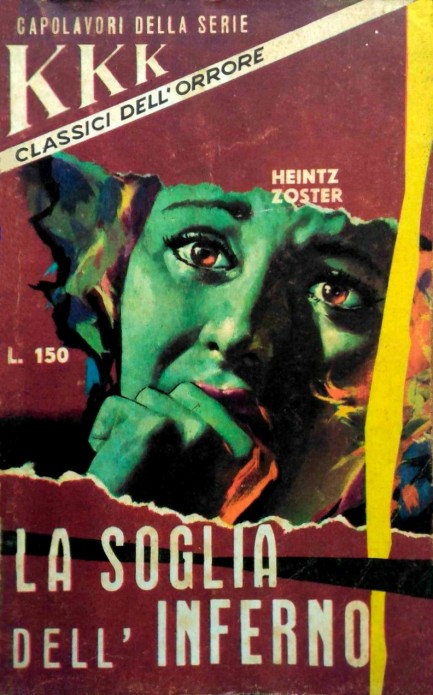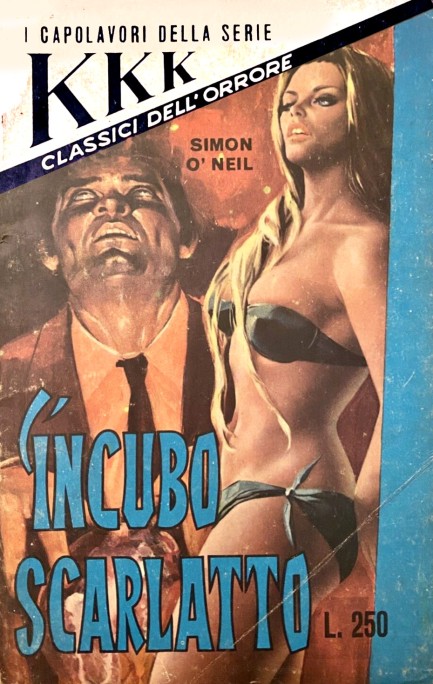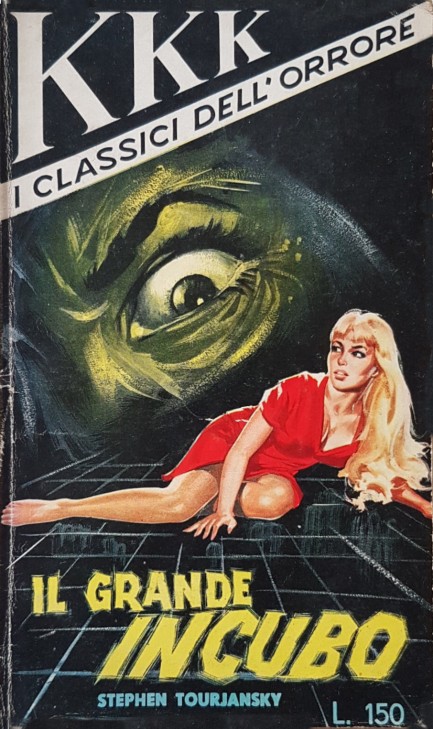 When you go out can you pick me up some Visine or Blink-n-Clean? My eyes are killing me. 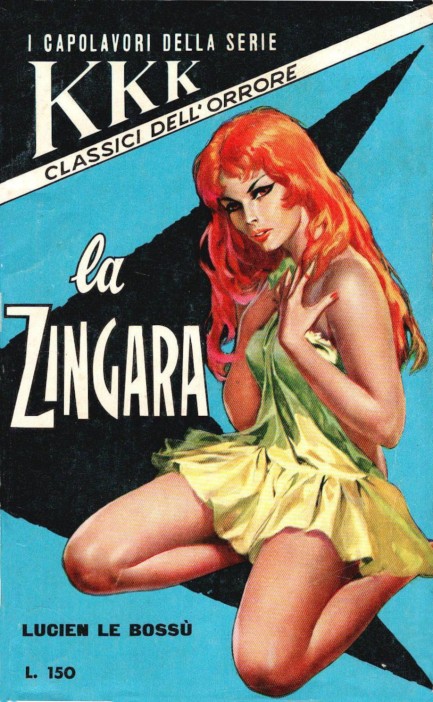
This is wonderful work from Italian illustrator Benedetto Caroselli, fronting Lucien Le Bossù's La zingara, which is number fifty-two in Grandi Edizioni Internazionali's series I Capolavori della Serie KKK Classici dell’Orrore. “Zingara” is Italian for gypsy, and this one has red hair and red eyes, which is not the first time Caroselli went this route with one of his women. The author here, Le Bossù was actually Renato Carocci, who wrote scores of books under too many pseudonyms to list, with this one coming in 1965. Caroselli was prolific, as well. If he didn't paint more covers than anyone else in Italy during the 1960s, he certainly came close.
 Most guys would sell their soul for someone this hot. 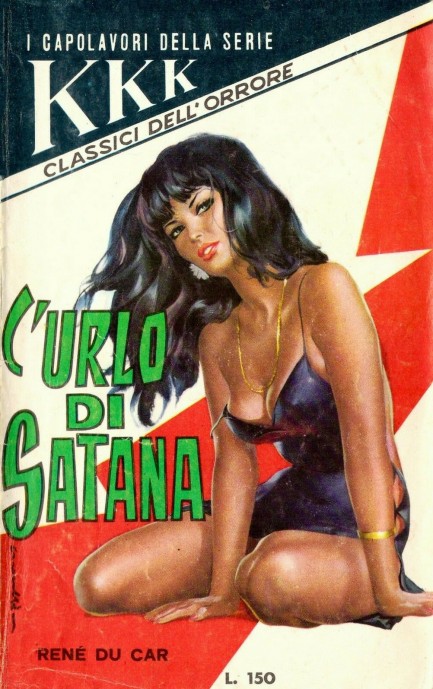
The 1965 horror novel L'urlo di Satana, the title of which means “the scream of Satan,” is number twenty-five in Rome based publisher Grandi Edizioni Internazionali's series I Capolavori della Serie KKK Classici dell’Orrore. It's credited to René du Car with a translation from French by Renato Carocci, but when GEI made such attributions what it really meant was that the translator wrote the book under a pseudonym. So this was actually written by Carocci, just one of scores of novels he produced under a long list of names. The art on this is another brilliant effort from Benedetto Caroselli, who we've documented extensively over the years. To see everything you can click his keywords below, or, if you're pressed for time, you can skip to our favorites here, here, here, here, and here.
 Caroselli chooses wisely for Italian book cover. 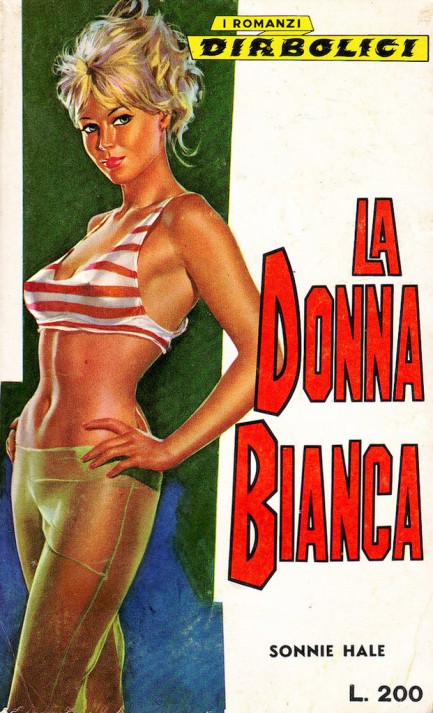 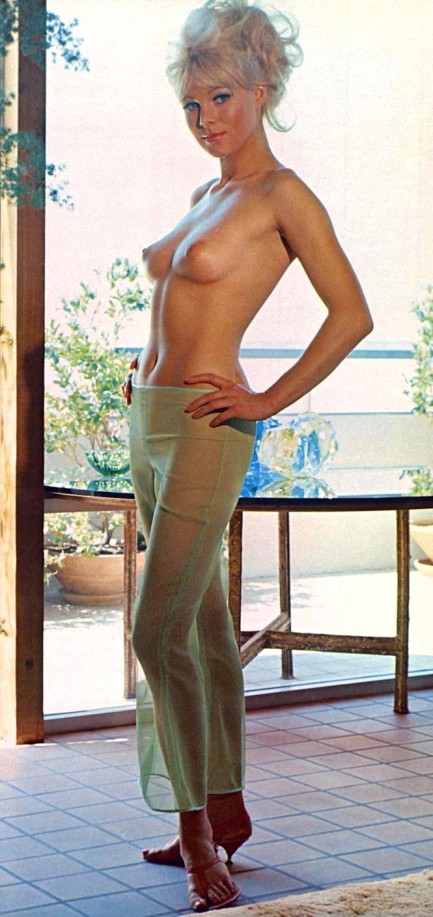
Inspiration is everything. Always draw from the best. Italian artist Benedetto Caroselli used a photo of svelte Austrian model Susan Denberg, aka Dietlinde Zechner, for this cover of Sonnie Hale's La donna bianca. That would translate as “the white woman,” but we think of her as the right woman. So did Playboy magazine, which made her its August 1966 Playmate of the Month. We doubt Denberg ever knew she was on this paperback, but we imagine she'd have been pleased with the result. It appeared in 1967 from Grandi Edizioni Internazionali as part of their I Romanzi Diabolici series. See plenty more from Caroselli, including other pieces he painted for this particular book series, by clicking his keywords just below.
 I'll run for help! Have you seen my red slingback pumps? 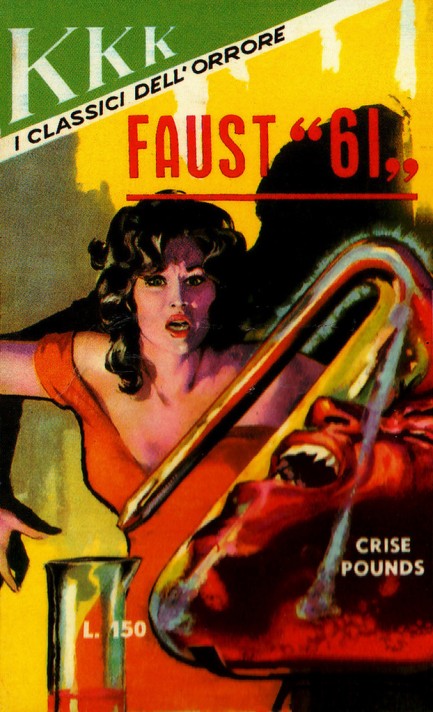
Our ongoing showcase of Italian artist Benedetto Caroselli continues with the above cover for Crise Pounds' novel Faust “61,” a horror update of the classic German folk legend. It was published in 1961 by Grandi Edizioni Internazionali for its series I Capolavori della Serie KKK Classici dell’Orrore. Pounds was a pseudonym used by Maria Luisa Piazza, who wrote three other novels for Grandi Edizioni Internazionali. Caroselli's cover work here shows his command of both subject matter and color. And fashion, as his stylish bystander looks on in terror.
 Caroselli bests the competition again. 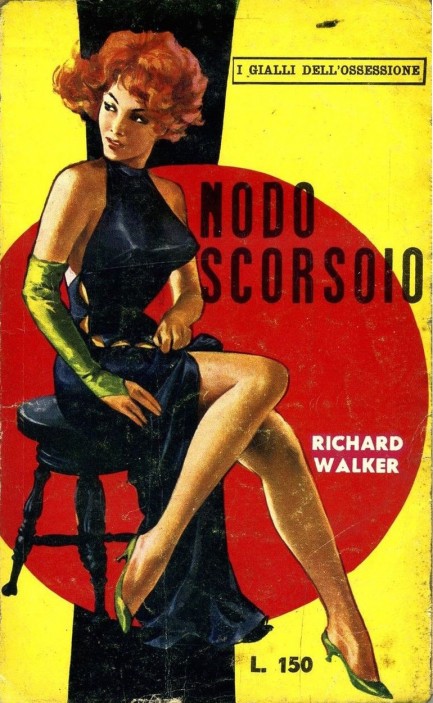
Above is another beautiful piece painted by Benedetto Caroselli, a man we're going to go ahead and anoint one of the greatest paperback cover artists of all time. His work on Richard Walker's Nodo scorsoio—which means “slipknot”—is simply brilliant, with its red tressed, black dressed femme fatale, and graphic background elements. It dates from 1962 for Grandi Edizioni Internazionali's collection I Gialli dell'Ossessione, and is number ninety-seven in the series. The book was translated from Richard Walker's original English text by Domenico Vitali, and once again we suspected the translator was the author, since we're pretty sure this book was never actually released in English, thus would never have needed a translator. After some searching we confirmed our suspicions—Vitali wrote as Walker on several occasions, including two novels for Éditions S.E.P.'s P.J. Police collection. We're going to keep digging up art by Benedetto Caroselli because it's all good—every piece we've seen. You can see more of his work by clicking his keywords below.
 Where there's a will-o'-the-wisp there's a way. 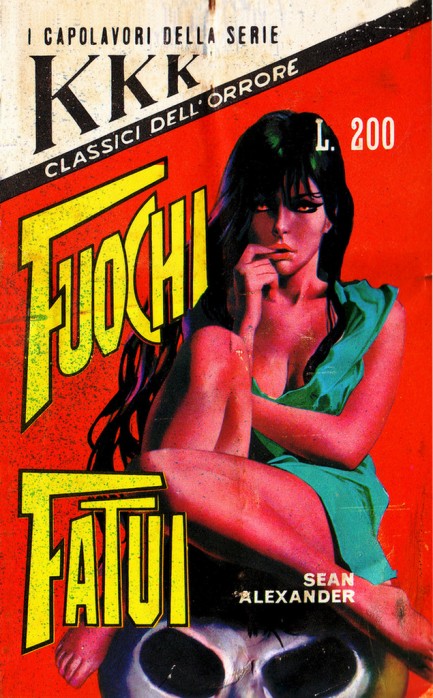
We probably should have shared this cover from Grandi Edizioni Internazionali's series KKK Classics around Halloween, because it's a bit scary. Then again, maybe now is better, because Christmas is possibly even a little scarier. The art here, from Benedetto Caroselli, has a red-eyed cover figure sitting atop what is supposed to be a giant skull, which, again, is a bit scary. However, if you look at it the right way she could be sitting on a giant nose. Again, possibly even scarier.
Inside the book you get two tales—the introductory “Welcome to Blackstone, Mister Clift,” by Silvano Alessandrini, followed by the full length title story. Fuochi fatui, by the way, translates as “fatuous fires.” What the hell does that mean? Fuochi fatui are basically analogous to will-o'-the-wisps, alluring lights in the wilderness that prove eternally elusive and lead to frustration and possibly danger. You can fill in your own Christmas shopping metaphor here.
Author Sean Alexander was aka Silvano Alessandrini. The pseudonym thing with French and Italian authors back in the day is a bit strange. Since they were selling to their home markets you'd think indigenous names would be an advantage, but it's clear that the type of mayhem and terror they were going for were thought to be more credible if written by Americans. Which when you think about it is possibly the scariest thing of all. Anyway, the copyright on this is 1969, and it's beautiful.
 “The Thing” that wasn't there. 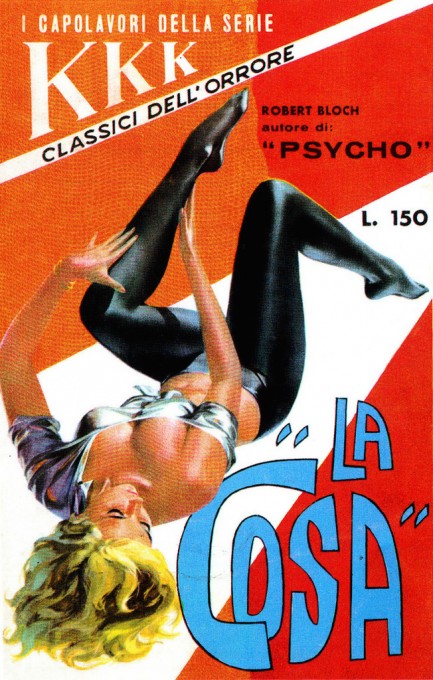
We've shared several covers from Grandi Edizioni Internazionali's horror collection I Capolavori della Serie KKK but this one is kind of special. Translated into Italian by Fernanda Adami, this is a collection of horror master Robert Bloch's early short stories. In case he isn't familiar to you, he wrote Psycho. This book is called La Cosa, or The Thing because Bloch's first story, a piece called “The Thing” appeared in his school magazine in 1932 when Bloch was only fourteen. But guess what? “The Thing” isn't one of the stories in The Thing. Instead the book consists of four tales—“Colui che apre la via,” “Ritorno a Sabbath,” “Il segreto di Sebek,” and “Enoch.” In English these are “The Opener of the Way,” “Return of the Sabbath,” “The Secret of Sebek,” and “Otis.” Just kidding—it's “Enoch.” Lovecraft fans probably already know of the first three stories because they appeared in Bloch's Lovecraft inspired collection The Opener of the Way in 1945 and remain widely read pieces of Lovecraftian lore. So that makes this paperback a bit of a collector's item. As if the great art by Benedetto Caroselli didn't already do that. Yes, he painted a misleading illustration for a horror anthology but Caroselli and Grandi Edizioni Internazionali specialized in that. Want to see a particularly brazen example? Check here.
 I usually wear floor length hoop skirts but for certain occasions this crimson mini is just the number. 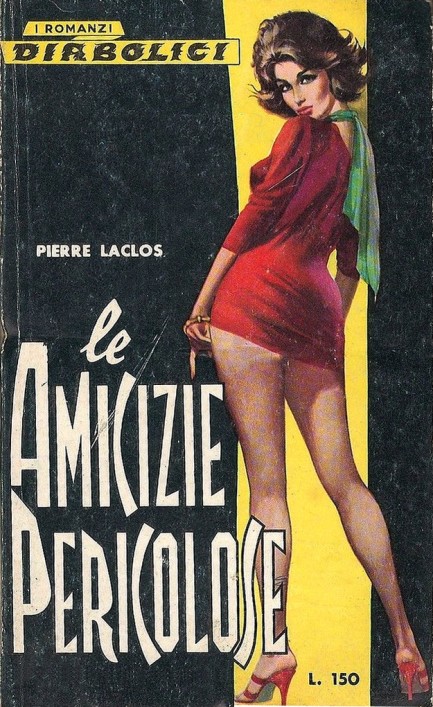
Sometimes when classic literature was remarketed for mid-century audiences the pulp style makeovers were stretches. But in this case it works. Le amicizie pericolose is a 1964 Italian translation of Pierre Choderlos de Laclos's 1782 French epistolary novel Les Liaisons dangereuses, aka Dangerous Liaisons. The story features one of history's greatest femmes fatales—Marquise de Merteuil, whose pride and sexual vanity is the seed of an unspeakable tragedy. There's also an homme fatale—the serial seducer Vicomte de Valmont, whose dick eventually gets him in a crack so tight he can't escape. The book has been filmed six times, and cinephiles argue which version is the best. While Glenn Close as the Marquise in 1988's Dangerous Liaisons was astounding, and Annette Bening's turn as the character in 1989's Valmont was also good, we recommend checking out Roger Vadim's 1959 adaptation, which was set in modern day Paris. Actually, even the 1999 Gen-X version Cruel Intentions is pretty good, which just goes to show how rich the source material is. There are also Korean and Chinese versions from 2003 and 2012 respectively.
The amazing femme fatale in red mini-dress and spike heels on the Grandi Edizioni Internazionali edition above—who of course looks nothing like the hoop skirted and white-powdered Marquise de Merteuil described by Laclos—was painted by the abundantly talented Bendetto Caroselli. Repackaging classics in this way (such as we've shown you before here and here) is usually a form of false advertising, but in this case we suspect many readers came away satisfied.
 This is a mean old world, baby, to live in all by yourself. 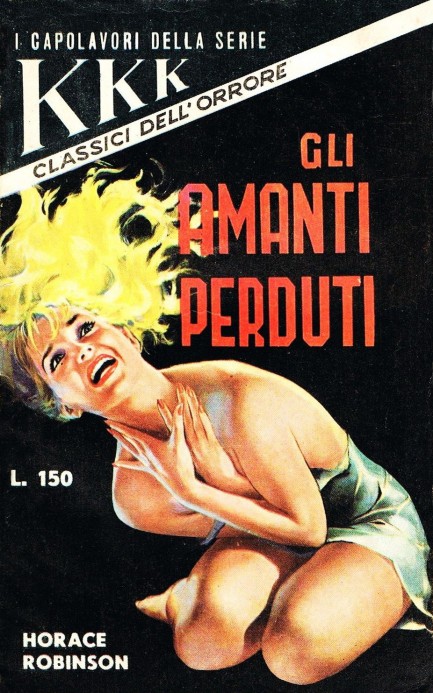
Above, the cover of Gli Amante Perduti, which means “the lost lover,” published 1962 by Grandi Edizioni Internazionali. The author, Horace Robinson, was in reality the prolific Maria Luisa Piazza, and the evocative cover art, showing a woman distressed and alone against a backdrop of blackness, is by the incomparable Benedetto Caroselli.

|
 |

The headlines that mattered yesteryear.
1939—Holiday Records Strange Fruit
American blues and jazz singer Billie Holiday records "Strange Fruit", which is considered to be the first civil rights song. It began as a poem written by Abel Meeropol, which he later set to music and performed live with his wife Laura Duncan. The song became a Holiday standard immediately after she recorded it, and it remains one of the most highly regarded pieces of music in American history. 1927—Mae West Sentenced to Jail
American actress and playwright Mae West is sentenced to ten days in jail for obscenity for the content of her play Sex. The trial occurred even though the play had run for a year and had been seen by 325,000 people. However West's considerable popularity, already based on her risque image, only increased due to the controversy. 1971—Manson Sentenced to Death
In the U.S, cult leader Charles Manson is sentenced to death for inciting the murders of Sharon Tate and several other people. Three accomplices, who had actually done the killing, were also sentenced to death, but the state of California abolished capital punishment in 1972 and neither they nor Manson were ever actually executed. 1923—Yankee Stadium Opens
In New York City, Yankee Stadium, home of Major League Baseball's New York Yankees, opens with the Yankees beating their eternal rivals the Boston Red Sox 4 to 1. The stadium, which is nicknamed The House that Ruth Built, sees the Yankees become the most successful franchise in baseball history. It is eventually replaced by a new Yankee Stadium and closes in September 2008.
|

|
|

It's easy. We have an uploader that makes it a snap. Use it to submit your art, text, header, and subhead. Your post can be funny, serious, or anything in between, as long as it's vintage pulp. You'll get a byline and experience the fleeting pride of free authorship. We'll edit your post for typos, but the rest is up to you. Click here to give us your best shot.

|
|

